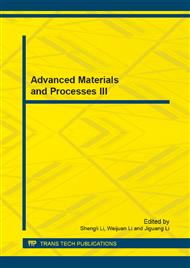p.1008
p.1015
p.1020
p.1026
p.1031
p.1035
p.1040
p.1044
p.1049
The Research on Milling Force in High-Speed Milling Nickel-Based Superalloy of Inconel 718
Abstract:
This paper makes an experiment in high-speed milling of Inconel 718. Cutting tests were performed using round and ceramic tools, at feeds from 0.06 to 0.14 mm/tooth, Axial Depth of Cut from0.5 to 1.5mm,and cutting speeds ranging from 500 to 1037 m/min. The behaviour of the cutting forces during machining was then measure. The results show that cutting force increases first and then decreases with the increase of feed per tooth, the tool chipping and groove wear were found with the increase of axial cutting depth, and cutting force is increased; the increase in cutting force with the cutting speed increases, when the cutting speed reaches a critical speed, the cutting force as the cutting speed increases began to decline.
Info:
Periodical:
Pages:
1031-1034
Citation:
Online since:
September 2013
Keywords:
Price:
Сopyright:
© 2013 Trans Tech Publications Ltd. All Rights Reserved
Share:
Citation:


